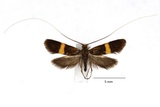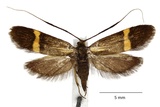Adela croesella (Scopoli, 1763) Species
Last modified: Dec. 16, 2025, 2:22 p.m.
A not so common species throughout Belgium.
Details
- Classification
- Family: Adelidae > Subfamily: Adelinae > Genus: Adela > Species: Adela croesella
- Vernacular names
- Gebandeerde langsprietmot (NL), Small Barred Long-horn (EN), Liguster-Langhornfalter (DE)
- Synonyms
- Adela sultzella (Linnaeus, 1767)
- First mention in Belgium
- De Fré Ch. 1858. Catalogue des Microlépidoptères de la Belgique. — Annales de la Société entomologique belge 2: 45–162. On page 116 (as Adela zultzella [sic]). view page
- Status
-
Native
Distribution
Imago
Wingspan 12–14 mm. This is the only Belgian Adela species with one transverse yellow band, somewhat similar to Nemophora degeerella which is almost twice as large and has a more pronounced yellowish pattern of longitudinal stripes. Males have long, slender antennae while the base of the antennae in the females is thickened with black scales with a bluish hue.
Caterpillar
White, semi-transparent showing the inner organs as reddish-brown structures. Head and prothoracic plate brown; meso- and metathoracic plates very light brown, almost the same colour as the abdominal segments.
Case
The larva constructs an oval case of many soil particles, sides slightly concave, 8–9 mm.
Bionomics
Oviposition in the flowers of mainly Ligustrum. The larvae are thought to feed at first on flowers and or seeds of the food plant. It builds later a portable flat, elongate-ovate case constructed from leaf fragments and covered with soil particles from which it feeds on fallen leaves, preferably in the shade of bushes. Hibernation as an almost full-grown larva. Pupation in the larval case.
The adults fly in the sunshine and later come occasionally to light. Most authors claim that the adults live separately but some have observed that they fly in swarms around bushes. Females hide during the day on bush leaves, mainly low to the ground. Males are much more active and search solitarily or in small groups for females.
Flight periods
The adults fly in one generation a year from late May till late June.
Observed on
- Host plant (species):
- Ligustrum vulgare, Hippophae rhamnoides and Fraxinus excelsior
- Host plant (genera):
- Ulmus
The larvae are thought to feed at first at flowers and or seeds of Ligustrum vulgare, Hippophae rhamnoides and other shrubs, like Cornus sanguineum and Olea europaea.
Habitat
Deciduous forest edges with bushes, mainly exposed to the south.




